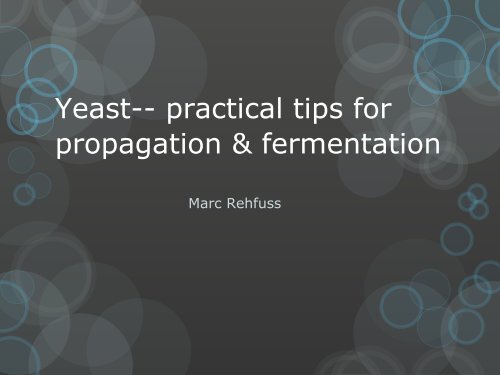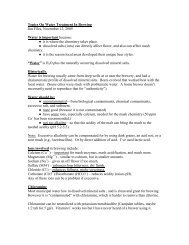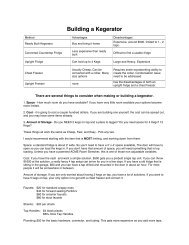Yeast - Bay Area Mashers
Yeast - Bay Area Mashers
Yeast - Bay Area Mashers
You also want an ePaper? Increase the reach of your titles
YUMPU automatically turns print PDFs into web optimized ePapers that Google loves.
<strong>Yeast</strong>-- practical tips for<br />
propagation & fermentation<br />
Marc Rehfuss
Outline<br />
A. <strong>Yeast</strong> propagation & storage best practices<br />
1. <strong>Yeast</strong> starters<br />
2. Freezing yeast for storage<br />
3. Storing yeast on agar slants<br />
3. Wort oxygenation<br />
B. <strong>Yeast</strong> fermentation byproducts<br />
1. diacetyl<br />
2. higher alcohols (fusels)<br />
3. esters<br />
4. acetaldehyde
<strong>Yeast</strong> starters, overview<br />
Goal is to produce, healthy,<br />
unstressed yeast cells in sufficient<br />
quantity to near ideal pitching rate<br />
Stir Plate with a 5L flask.<br />
Ideal yeast pitching rate:<br />
Ales = 1 x 10 6 cells / mL per ° plato<br />
Lagers = 1.5-2 x 10 6 cells / mL per ° plato<br />
Erlenmeyer flask + stir plate has<br />
highest cell yield<br />
Intermittent shaking second best<br />
Poorest cell yield in simple starter<br />
(no shaking or aeration)<br />
Don’t skimp on yeast!<br />
Go big or go home.
<strong>Yeast</strong> starter, basic protocol<br />
A 10% DME solution is optimal (100g DME<br />
per 1L H 2 O) OG=1.040. Boil for 10 min<br />
(Fermcap S highly recommended!) & cool.<br />
Grow at room temp with gentle vortex (if<br />
using stir plate) for 24-48 hours<br />
Crash cool to drop yeast, pour off most of<br />
spent starter wort, swirl settled yeast into<br />
a slurry, pitch
Freezing yeast for storage<br />
Why? -- Saves money & can<br />
have yeast bank of seasonal or<br />
discontinued strains indefinitely<br />
Requires ~25% glycerol (AKA<br />
glycerin) as a cryoprotectant-- Can<br />
buy glycerin in health food stores<br />
Freezing yeast in plastic conical<br />
tubes works very well– Can buy<br />
conical tubes online. Amazon has<br />
50pk for $10.<br />
Food grade<br />
vegetable<br />
glycerine<br />
bought from<br />
organic market<br />
50 mL conical<br />
tube
Freezing yeast, brief protocol<br />
1) Add 10mL glycerol to 50 mL<br />
conical tubes.<br />
2) Decant starter supernatant<br />
3) Swirl to resuspend yeast<br />
into a slurry (want very high<br />
cell density)<br />
4) Carefully pour 30 mL of<br />
slurry into conical tube to 40<br />
mL mark, mix very well.<br />
5) Place tube in freezer in<br />
small styrofoam cooler– this<br />
prevents freeze-thaw damage<br />
(if frost free freezer)<br />
Conical with 10<br />
mL glycerol<br />
Settled yeast starter.<br />
Decant most liquid<br />
<strong>Yeast</strong> slurry with<br />
25% glycerol<br />
ready to be frozen
Reviving frozen yeast, brief protocol<br />
1) Thaw out frozen yeast completely in fridge.<br />
2) Mix gently to dislodge any suspended yeast<br />
3) Add entire contents of conical to 200-250 mL prepped<br />
starter wort.<br />
4) Place onto stirplate for 24-48 hours.<br />
5) Add additional wort to step up to desired volume, no<br />
more than 10x dilution.
Storing yeast on agar slants<br />
<br />
<br />
<br />
Why? -- Saves money & can<br />
have yeast bank of seasonal or<br />
discontinued strains indefinitely<br />
Pros vs freezing yeast–<br />
-no freezing required, less space<br />
-can visually determine purity<br />
Cons vs freezing yeast<br />
Materials required:<br />
-requires good aseptic technique!<br />
-requires periodic subculturing to<br />
maintain viability<br />
-more prone to mutation<br />
-agar can be messy and is not<br />
cheap<br />
-can be a PITA<br />
5-6in glass<br />
vial w/screw<br />
cap<br />
OR<br />
Steel Plastic<br />
inoculating inoculating<br />
loop loop<br />
Materials recommended:<br />
agar<br />
Test tube<br />
rack<br />
Small Erlynmeyer flask or beaker (100mL – 500mL)<br />
Butane torch or flame source<br />
Pressure cooker
Pouring agar slants, brief<br />
protocol<br />
1) Make sure glassware is clean.<br />
2) Prep starter wort at usual concentration<br />
but add 1.5% agar (e.g 3.75g agar per<br />
250mL wort)<br />
3) Boil for 15 min. Agar will dissolve in a few.<br />
Better yet, place tubes in pressure cooker to<br />
sterilize.<br />
4) If using flask or beaker, using mitts,<br />
carefully pour ~1/2 vol of melted agar + wort<br />
into glass tubes in rack. If boiling in pot,<br />
slowly draw out liquid with metal turkey<br />
baster and squirt gently into tubes<br />
4) Cap tubes and invert on raised surface<br />
(e.g thin book)<br />
5) Let solidify for a few hours. Cap and store<br />
at RT or in fridge.
Inoculating & reviving agar slants,<br />
brief protocol<br />
1) From WL vial or Wyeast packet, insert sterile loop. If metal loop, flame til red<br />
hot to sterilize.<br />
2) Remove loop, and working quickly, gently cross the agar slant surface<br />
using as much area as possible.<br />
3) Apply cap loosely, and leave at RT for a few days.<br />
4) When opaque, white colonies are visible, tighten cap and place in fridge.<br />
Agar slant with<br />
yeast colonies<br />
5) To restart, take a hearty loopful of growth in 25-100mL fresh wort. Mix very<br />
well.<br />
6) When fermentation is evident, transfer to larger volume, no more than a 10x<br />
dilution.
Wort oxygen<br />
O 2 needed to synthesize cell membrane sterols and unsaturated<br />
fatty acids<br />
<strong>Yeast</strong> growth is sterol limited<br />
Wort oxygenation at onset is crucial. 8-10ppm O 2 desirable for<br />
typical wort gravities. O 2 requirement is strain dependent.<br />
Poor oxygenation results in poor yeast vitality and poor<br />
fermentation performance<br />
O 2 needed<br />
for synthesis<br />
O 2 needed<br />
for synthesis
Using pure O 2 is easiest & most effective way to oxygenate<br />
Using an oxygen canister with a<br />
sintered 0.5 µm stone is the fastest,<br />
most sanitary method. 1 min is more<br />
than enough.<br />
Shaking the carboy (~5 min) works<br />
fine, if you love a workout<br />
Pumping filtered air (e.g. with an<br />
aquarium pump) is fine, just takes a<br />
while (~25 min)<br />
O 2 stone costs ~45$. O 2 tank is $8-$9 and lasts ~15 batches.
<strong>Yeast</strong> fermentation byproducts<br />
Crucial sensory components of beer<br />
diacetyl<br />
Higher alcohols (fusels)<br />
esters<br />
acetaldehyde
Diacetyl (2,3 butanedione)<br />
Is highly flavor active (buttery) VDK, along with 2,3 pentanedione.<br />
Low flavor threshold of 0.02 mg / L<br />
Produced as an intermediate in valine synthesis<br />
H 3 C<br />
Diacetyl<br />
=O<br />
C<br />
C<br />
=O<br />
CH 3<br />
Wort carbohydrates<br />
glucose<br />
pyruvate<br />
Acetolactate<br />
synthase<br />
2,3-butanediol<br />
Leaks<br />
out of<br />
cell<br />
2,3-butanediol<br />
(almost no flavor)<br />
α -acetolactate<br />
acetoin<br />
Leaks<br />
out of<br />
cell<br />
α -acetolactate<br />
valine<br />
Non-enzymatic<br />
decarboxylation<br />
2NAD+<br />
2NADH<br />
diacetyl<br />
diacetyl<br />
Blue lines =<br />
enzymatically<br />
mediated rxn<br />
Orange lines =<br />
passive process<br />
CO 2
Factors affecting diacetyl<br />
formation & removal<br />
Provide wort with adequate FAN (not a problem with all malt<br />
grist)<br />
Healthy pitching yeast in proper quantity will facilitate diacetyl<br />
reduction<br />
Increase fermentation temp 3/4 the way to final gravity to speed<br />
up rate of diacetyl reduction– not always necessary with ales<br />
Maturex TM ? -- converts α –acetolactate -> acetoin directly<br />
Pediococcus infection results in high amounts of diacetyl.
Higher alcohols (fusels)– “solvent” like<br />
R<br />
alcohol<br />
O<br />
H<br />
In worts with ample FAN:<br />
Wort carbohydrates<br />
In worts with insufficient FAN:<br />
Wort carbohydrates<br />
glucose<br />
glucose<br />
Wort amino<br />
acids<br />
(FAN)<br />
FAN<br />
Transamination<br />
oxoacid<br />
No FAN available<br />
for transamination<br />
oxoacid (accumulates)<br />
Decarboxylation<br />
to aldehyde<br />
CO 2<br />
Amino acid<br />
proteins<br />
Blue lines =<br />
enzymatically<br />
mediated rxn<br />
Orange lines =<br />
passive process<br />
aldehyde<br />
2NADH<br />
2NAD+<br />
Higher<br />
alcohol<br />
Alcohol<br />
Dehydrogenase<br />
Leaks<br />
out of<br />
cell<br />
Higher<br />
alcohol
Factors affecting higher alcohol formation<br />
Provide wort with adequate FAN (not a problem with all malt grist)<br />
Healthy pitching yeast in proper quantity will lower production of higher<br />
alcohols<br />
Keep fermentation (not ambient!) temperatures within optimum range<br />
for yeast strain<br />
higher temps = rapid growth = excess oxo acid pool = higher alcohols<br />
Johnson A419 digital<br />
external thermostat<br />
Johnson analog<br />
external thermostat<br />
Buy a used<br />
fridge or<br />
freezer,<br />
Plug it in,<br />
set and<br />
forget!
Esters<br />
Highly flavor active (fruity) compounds– banana, pear, brandylike<br />
Produced when an alcohol reacts with an acyl CoA<br />
R<br />
ester<br />
=O<br />
C<br />
OR’<br />
Alcohol + Acyl CoA<br />
R’-OH R-CH 2 CSCoA<br />
=O<br />
Alcohol<br />
Acetyltransferase<br />
(ATF)<br />
ester<br />
R-CH 2 COCH 2 -R’<br />
=O<br />
Wort carbohydrates<br />
glucose<br />
oxoacid<br />
aldehyde<br />
2NADH<br />
2NAD+<br />
Alcohol<br />
Dehydrogenase<br />
ester<br />
Leaks<br />
out of<br />
cell<br />
Acyl-CoA<br />
ester<br />
alcohol<br />
ATF<br />
Leaks<br />
out of<br />
cell<br />
(Higher)<br />
alcohol
Examples of esters<br />
Name Formula Characteristic Concentration<br />
(mg / L)<br />
Flavor<br />
threshold<br />
(mg / L)<br />
Ethyl acetate Pear-like 8-70 33<br />
CH 3 CH 2 OCCH 3<br />
=O<br />
Isoamyl<br />
acetate<br />
CH 3<br />
=OCH3<br />
CHCH2CH2OCCH3<br />
banana 0.4-6 1.6<br />
Ethyl<br />
octanoate<br />
Ethyl<br />
caproate<br />
CH 3 CH 2 OC(CH 2 ) 6 CH 3<br />
=O<br />
CH 3 CH 2 OC(CH 2 ) 8 CH 3<br />
=O<br />
Floral, brandylike 1.5 0.9<br />
Goaty, barnyard 0.2-? 1.5
Factors affecting ester formation<br />
Increase in wort gravity increases esters<br />
Provide wort with adequate FAN (not a problem with all malt<br />
grist)<br />
Healthy pitching yeast in proper quantity will lower production of<br />
higher alcohols, thus lowering ester formation potential<br />
Ensure wort oxygenation is adequate<br />
Keep fermentation (not ambient!) temperatures within optimum<br />
range for yeast strain<br />
higher temps -> rapid growth -> excess oxo acid pool -> higher alcohols -> esters
Green apple like in aroma and flavor<br />
Acetaldehyde<br />
H 3 C<br />
=<br />
O<br />
C<br />
H<br />
<br />
<br />
Produced as an intermediate in alcohol pathway– Stressed yeast produce more<br />
Alcohol dehydrogenase requires Zn +2 as cofactor. Worts low in Zn +2 have increased<br />
acetaldehyde<br />
Wort carbohydrates<br />
glucose<br />
Oxoacid(pyruvate)<br />
acetaldehyde<br />
2NADH<br />
2NAD+<br />
alcohol<br />
Pyruvate<br />
decarboxylase<br />
Alcohol<br />
Dehydrogenase<br />
Leaks<br />
out of<br />
cell<br />
acetaldehyde<br />
Leaks<br />
out of<br />
cell<br />
ethanol
Factors affecting acetaldehyde levels<br />
Low zinc levels– usually not a problem with all malt. Can<br />
supplement to 0.1-0.2mg/L<br />
Provide wort with adequate FAN (not a problem with all malt<br />
grist)<br />
Healthy pitching yeast in proper quantity will allow yeast to<br />
reabsorb acetaldehyde<br />
Ensure wort oxygenation is adequate– some evidence that<br />
excessive aeration will increase acetaldehyde<br />
Don’t transfer / keg too soon.
Summary<br />
Grow lots of yeast and treat it well.<br />
Happy, healthy yeast = better beer (duh)





